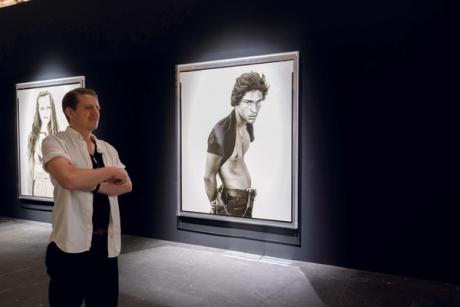
In the past, photography was marginalized at Art Basel, literally. The stands surrounding the courtyard of the Rundhof have always been filled with paint. But almost all of the camera-based art has been tucked away in a corner of the main fair or, more recently, packed into Photo Basel’s smaller fringe event, located off-site at the Volkshaus Basel.
With the exception of a few stalwarts of classic modern photography, such as San Francisco’s Fraenkel Gallery and New York’s Howard Greenberg Gallery, few Art Basel exhibitors have traditionally found a niche for this medium. But this year, a change seems to be taking place. A deeper, wider and more diverse range of photography, across vintage, modern and contemporary, is now on sale at the fair.
“Compared to the early days, collectors are infinitely more receptive to collecting works by photographers,” explains Edwynn Houk, director of the eponymous New York gallery. He is a gallery owner specializing in photography who sells works by Man Ray, Henri Cartier-Bresson, Imogen Cunningham and Tina Modotti at Art Basel.
“Compared to the first times, collectors are infinitely more receptive”
Edwynn Houk, director of the eponymous New York gallery
Part of the reason for this change may lie in the gravitational pull of mega galleries. Hauser & Wirth’s portrayal of Cindy Sherman in 2021 was a landmark event for photography. Sherman began working in the 1970s and, at times, felt rightly ignored by mainstream art fairs. As a result, his work sold on the same footing as Louise Bourgeois, Hans Arp, Philip Guston et al.
In March, Gagosian announced he would represent Nan Goldin, an artist whose market remained in the doldrums for more than a decade as she recovered from an addiction to prescribed opioids. Gagosian supported him by bringing to the fair original prints of Francesca Woodman, the prodigious self-portraitist who committed suicide in 1981, aged 22. The gallery has also chosen a rather unusual series of works by Richard Avedon, entitled In the American West (1979-84), such as its unlimited supply.
Blue Chips’ interest in photography “was gradual, building probably over 15 years,” Houk says. “But the big galleries now take photography very seriously.” And there is a trickle down effect. Small galleries also seem willing to take more risks, showing photographers or series that have not yet acquired a serious institutional pedigree, or that have been ignored by previous generations.
New names are also introduced. Thomas Zander highlights large-scale contemporary work by young London-based Polish photographer Joanna Piotrowska, while Frankfurt’s Jacky Strenz Galerie dedicated its stand to austere images by the late American photographer Lynne Cohen. “She was famous, but she wasn’t a superstar, even in photography,” Strenz admits. A number of Cohen’s photographs were sold on the fair’s first VIP day, but the gallery declined to reveal how many.
Ongoing reassessment
The increased interest in photography can perhaps also be attributed to the death of George Floyd, after which some galleries began to offer works by neglected black photographers, mainly from the United States. Gordon Parks, the first black photographer to work on the famous Life magazine, is one of the artists who quickly received posthumous reappraisal, both institutionally and commercially. His works are on sale at Art Basel this year with New York’s Jenkins Johnson Gallery, among others.
Does it lead to sales? So far, the more established names are getting noticed. London’s Maureen Paley Gallery reported an early sale of a Wolfgang Tillmans image for $120,000, while Gladstone Gallery sold a Robert Mapplethorpe photograph for $75,000. But a new work by Iranian artist Shirin Neshat remains, at this stage, unsold by Gladstone. “There is tremendous interest in his work and we will continue to have conversations,” says Caroline Luce, gallery partner.
The big beasts seem set to maintain their interest in the traditional underdog of the art world. But the big galleries are unlikely to start supporting young photographers anytime soon. For what? Because numbers don’t work. “If the big galleries start representing someone, they have to be at least a mid-career artist, if not beyond,” Houk says, “because of the economy.” Perhaps due to its reproducible nature, photography does not have the same price as painting. Until then, photographers will still struggle to gain the same audience as the deans of other media.
